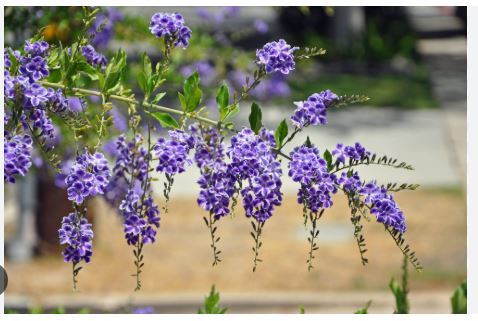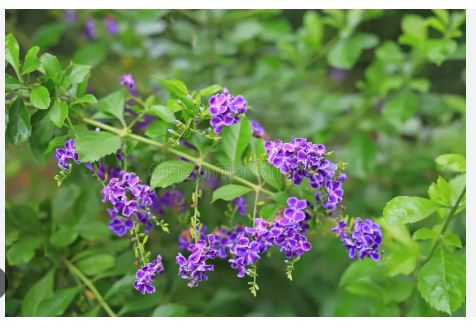
Duranta erecta, commonly known as Sky Flower, Golden Dewdrop, or Pigeon Berry, belongs to the Verbenaceae family, which includes other ornamental plants like verbena and lantana. The genus Duranta, named after 16th-century Italian botanist Castore Durante, comprises about 30 species of tropical shrubs and trees.
The species name erecta, Latin for “upright,” reflects its typical growth habit, though it can also sprawl. Taxonomically, it has synonyms like Duranta repens and Duranta plumieri, reflecting historical reclassifications. This evergreen shrub is a staple in tropical horticulture, prized for its vibrant blooms and versatility.
Sky Flower is a fast-growing, evergreen shrub or small tree, typically reaching 4–20 feet (1.2–6 meters) tall and wide, though some cultivars stay smaller. Its glossy, oval to elliptic leaves, 1–3 inches (2.5–7.5 cm) long, are light to dark green, sometimes variegated or golden, with serrated margins.
From spring to fall, it produces cascading clusters (racemes) of tubular, 0.5-inch (1.3 cm) flowers in blue, purple, or white, often with white edges, exuding a light fragrance. These give way to glossy, yellow-orange berries, 0.3–0.5 inches (7–11 mm) across, which persist into winter. Mature plants may develop axillary thorns, absent in younger specimens, and branches often droop under the weight of flowers and fruit, creating a weeping effect. The berries and leaves are toxic to humans and pets, though birds consume the fruit safely.
Native to tropical and subtropical Americas, Duranta erecta spans southern Florida, Texas, Mexico, Central America, the Caribbean, and much of South America, including Brazil, Argentina, and Paraguay, thriving in scrublands, woodlands, and coastal areas. Widely cultivated as an ornamental, it has naturalized in regions like Australia, Hawaii, South Africa, and parts of Asia, sometimes becoming invasive, particularly in Queensland and New South Wales, where its dense growth displaces native flora. While possibly native to South Florida based on historical records, it’s often considered introduced in Texas and Arizona. Its global spread reflects its adaptability to warm, sunny climates and horticultural popularity.
Duranta erecta is hardy in USDA zones 9a–11b, flourishing in temperatures above 20°F (-6.7°C). In zones 9a–9b, it may drop leaves or die back during rare frosts (lows of 25–30°F/-4 to -1°C) but often regrows from roots in spring. In zones 10–11, it remains evergreen, blooming nearly year-round in frost-free areas. Below zone 9, it’s grown as an annual or container plant, moved indoors before frost to overwinter in bright, warm conditions (50–70°F/10–21°C). Its tolerance for heat and humidity makes it ideal for southern U.S., Caribbean, and Mediterranean climates, though it needs well-drained soil to thrive.
Sky Flower is a versatile ornamental, valued for its vibrant flowers and golden berries, making it a focal point in tropical and subtropical gardens. Its weeping habit and dense foliage suit hedges, privacy screens, or informal barriers, growing 10–15 feet (3–4.5 meters) wide to define spaces. Smaller cultivars like ‘Gold Mound’ (3–4 feet/0.9–1.2 meters) excel in low borders, containers, or mass plantings, adding color to patios and balconies.
It attracts butterflies, hummingbirds, and bees, enhancing pollinator gardens, while birds feast on its berries. In xeriscapes, its drought tolerance (once established) shines, though it requires pruning to maintain shape and prevent overgrowth near paths, as thorns on mature plants pose risks. Toxic berries necessitate placement away from children and pets, but its adaptability to sun or part shade ensures broad appeal in warm-climate landscapes.

How To Grow And Care For Sky Flower (Duranta erecta)
Light Requirements
Provide full sun to partial shade, with 6–8 hours of direct sunlight daily for optimal flowering and lush foliage. In hotter climates, afternoon shade prevents leaf scorch, while full sun enhances bloom intensity. Indoors or in low-light areas, use grow lights or a south-facing window to mimic its sunny preferences.
Soil Preferences
Plant in well-draining, fertile soil with a pH of 5.5–7.5, such as loamy or sandy soil enriched with compost. It tolerates poor soils but thrives with good drainage to avoid root rot. In containers, use a multipurpose potting mix with added perlite or sand to ensure aeration and drainage.
Watering Needs
Water regularly during the first year to establish roots, providing 1–2 inches (2.5–5 cm) weekly, keeping soil moist but not soggy. Once established, water every 7–10 days in summer, allowing soil to dry slightly between waterings, and reduce in winter. Overwatering causes yellowing leaves, so check soil moisture before watering.
Temperature Range
Grow in USDA zones 9a–11b, where temperatures range from 20°F to 90°F (-6.7°C to 32°C). It tolerates brief frosts but may defoliate below 25°F (-4°C); protect with frost cloth in zones 9a–9b. In colder zones, cultivate in pots and move indoors during winter, maintaining above 50°F (10°C).
Humidity Levels
Thrive in moderate to high humidity (50–70%), typical of tropical climates. Low humidity in arid regions may cause leaf drop; mist occasionally for potted plants or use a pebble tray indoors. Ensure good air circulation to prevent fungal issues, especially in humid, coastal areas.
Container Selection
Choose pots with drainage holes, at least 14–20 inches (35–50 cm) wide, to accommodate its spreading roots and bushy growth. Heavy ceramic or plastic pots prevent tipping for larger specimens. Repot every 2–3 years to refresh soil, ensuring space for its vigorous habit.
Fertilization
Apply a balanced, slow-release fertilizer (e.g., 10-10-10 NPK) in early spring and midsummer to boost growth and flowering. Alternatively, use diluted liquid fertilizer monthly during spring–summer. Avoid over-fertilizing, as excess nitrogen reduces blooms; skip feeding in fall–winter to respect dormancy.
Pruning
Prune in late winter or early spring to shape, remove dead or leggy branches, or control size, using clean shears to cut just above a node. Trim after flowering to encourage bushiness and prevent berry litter. Regular pruning manages thorns on mature plants and maintains tidy hedges or container forms.
Propagation
Propagate via softwood cuttings or seeds. Take 4–6-inch (10–15 cm) cuttings in spring, dip in rooting hormone, and plant in a moist, well-draining mix; roots form in 4–6 weeks. Seeds, sown at 70–75°F (21–24°C), germinate in 2–4 weeks but are slower to mature. Cuttings ensure true-to-type plants.
Pest Control
Monitor for pests like aphids, whiteflies, or scale, which may target tender leaves or stems. Inspect regularly, treating infestations with insecticidal soap or neem oil in early morning. Maintain healthy growth with proper watering and airflow to reduce pest susceptibility, as stressed plants attract more insects.
Repotting
Repot every 2–3 years in spring, or when roots outgrow the container. Gently remove, trim circling roots, and replant in fresh potting mix at the same depth. Water lightly after repotting and provide shade for a week to minimize shock, ensuring the pot has excellent drainage.
Winter Care
In zones 9a–9b, mulch the base with 2–3 inches (5–7.5 cm) of bark to insulate roots during cold snaps; cover with frost cloth if freezes are forecast. Indoor plants need bright light, cool temperatures (50–60°F/10–16°C), and reduced watering to overwinter, mimicking semi-dormancy.
Common Issues
Address overwatering (yellow leaves, root rot) by improving drainage and reducing frequency. Underwatering (drooping, leaf drop) requires slight watering increases. Poor flowering may indicate insufficient light or excess fertilizer; adjust sun exposure or feeding. Fungal leaf spots from humidity are mitigated with better airflow and less overhead watering.